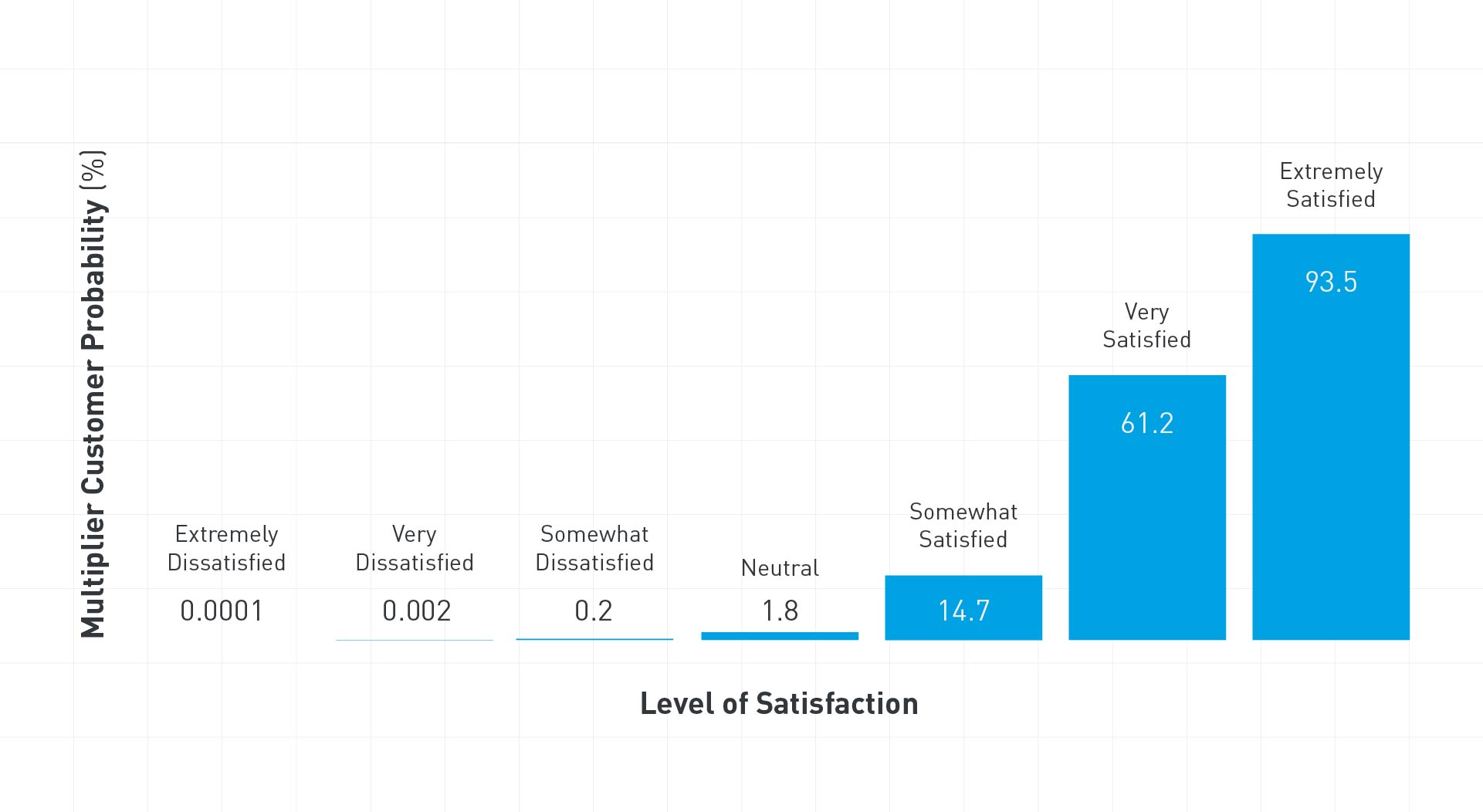Article
Multiplier Customers: Targeting Profitable New Clients

All customers are not the same. Some generate only one-time business. Others can help grow a firm organically through repurchasing, recommending the business to peers, inviting bids on new business, and offering positive word-of mouth.
Customers who engage in these behaviors are “multiplier customers”: they help firms multiply their business growth.
Multiplier customers who offer peer recommendations and repeat business are especially critical for industrial business-to-business (B2B) companies that offer specialized products and solutions to meet complex customer needs and for whom the cost of customer acquisition can be high. Without multiplier customers, B2B companies see increased customer acquisition costs, may have lower sales per customer, and fail to deliver the desired financial results.
Multiplier customers essentially serve as additional salespeople for their suppliers by inducing trust and confidence among other prospective buyers. They provide information about the health of a company’s customer base. At the 100,000-foot level, multiplier customers enable the CEO to measure the health the company’s core asset, its customer base.
So how can a B2B company build a solid base of multiplier customers? As shown in a recent analysis by BrandExtract research partner, Customer-Based Execution & Strategy (CUBES®), it starts with a focus on overall customer satisfaction.
Satisfied, Profitable Customers
Why should a B2B firm focus on multiplier customers? Because they are inherently more satisfied than the average customer, multiplier customers are more likely to engage in behaviors that lead to three benefits for a firm.
- They lower the cost of acquiring other new customers
- They help you avoid the value trap
- They are less likely to switch to a competitor
First, multiplier customers lower the cost of acquiring new customers through peer recommendations and positive word of mouth. When dealing with complex goods and services, as is the case for industrial B2B companies, positive word of mouth and recommendations can provide credible and useful information to other potential customers. Relative to advertising and collateral, word of mouth and recommendations are powerful signals because they summarize the entire experience of an existing customer for potential customers.
Second, multiplier customers help avoid the “value trap,” a condition often encountered by B2B companies in which they feel pressure to improve product performance by adding more and better features. This increases their costs, but because of clients’ pricing leverage, they are unable to pass on the costs and margins erode.
Due to their higher overall satisfaction, multiplier customers are less price-sensitive and are more likely to engage in future business with a firm. A higher level of satisfaction provides the psychological comfort to re-engage with the supplier because the customer’s needs are well met. As such, companies do not have to provide multiplier customers with increasing numbers of features, which raise costs, or steep price discounts, which erode margins, to retain them. This obviates the value trap.
Third, multiplier customers are less likely to switch to a competitor should the other supplier lower its price or provide more features. Multiplier customers are reluctant to break relationships and more likely to give current suppliers a chance to match competitors’ offerings, trust the existing vendors’ offerings, and sign share of wallet contracts. However, this occurs only within the zone of tolerance — the competitors’ offer cannot be intolerably better.
Despite this straightforward intuition, identifying multiplier customers has not been easy for B2B companies. Fortunately, our research is designed to help address this issue.
Identifying Multiplier Customers
How do B2B companies convert existing customers into multiplier customers? Results from our research project indicate firms can grow a base of such customers by focusing on overall satisfaction.
In the study, customers rate a specific supplier on overall satisfaction and whether they will be “extremely likely” to:
- Use this supplier for their next project/job
- Recommend this supplier to a colleague/friend
- Say positive things about this supplier if someone asks
- Invite this supplier to provide a quote/bid if the opportunity arises
A customer was defined as a multiplier customer if they are “extremely likely” to engage in all four of these behaviors. Indeed, a multiplier customer offers the highest possible chance of all four behaviors. Next, our team statistically estimated the likelihood of generating multiplier customers at each level of overall customer satisfaction.
Using this methodology, the study provides a quantitative metric to assess customer quality. A firm can answer the key question: As overall customer satisfaction increases, what is the probability of generating a multiplier customer?
The Probability of Generating a Multiplier Customer
The results summarized in Figure 1 below show the probability of generating a multiplier customer at different levels of overall customer satisfaction. Specifically, they demonstrate:
- The probability of generating a multiplier customer is almost zero when a firm’s customers are in the dissatisfied range or indifferent (“neither satisfied nor dissatisfied”). Customers who are dissatisfied or indifferent do not generate multiplier customers.
- In the satisfied range, the probability of generating a multiplier customer rises, but non-linearly. “Somewhat satisfied” customers have a 14.7% chance of being multipliers, “very satisfied” customers have 61.2% chance of being a multiplier, and extremely satisfied customers jump to a 94.5% chance.
Figure 1. Probability of Generating a Multiplier Customer

If businesses want to improve the quality of their customer base and cultivate a larger share of multiplier customers, they must focus on making buyers “very” or “extremely” satisfied. Extremely satisfied customers have an almost 1-to-1 conversion probability of becoming multiplier customers.
Multiplier customers not only reduce customer acquisition costs, but they also drive down price elasticity and competitive switching. Both these effects can help a company to increase sales while expanding margins.
What’s Next?
A central concern for every B2B firm is improving the quality of its client base, and our team provides an easy way to measure customer quality. Businesses can quantify the percentage of their customer-base that qualifies as a multiplier, the likelihood of generating multiplier customers, and the potential impact on sales and margins by examining overall customer satisfaction. At the 100,000-foot level, this reduces guesswork and aids the CEO in managing one of the most crucial assets of a company — its customer base.
Our team has shown overall customer satisfaction is associated with increased sales, margins, and customer quality. What effect might satisfaction have on pricing power? We intend to address this question in a future brief.
A Few Extra Insights
Hopefully, you now have a better understanding of what a multiplier customer is and how to identify them. If you want to learn about multiplier customers and how to find them for your own business, we'd love to chat. If you want to learn more about branding and the impact of data on your business, check out these resources:
- See how data science can impact branding.
- Discover which customer metrics predict the best financial performance.
- Understand how your brand strategy drives business growth.
- Learn how to use analytics to optimize marketing spend.
